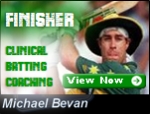|

I was terrible at science when at school. I couldn't see the relevance of it and found every way possible of avoiding lessons. However, the bit that I did like was experimentation.
The fact that I was allowed to try things, to see if they work or don’t work was great and I have taken that on into my coaching.
Experiment with these opposites with your individual players and see what impact they have on their performance/experience when catching and batting.
Wide stance v narrower stance
Ask the player to hit 10 front foot drives with a wider stance and then 10 with a narrower one.
Ask for their feedback on how easy they found it to move to the ball (get them to rate their movement out of 10 for each ball and keep a log).
See which one scores higher.
Is it their existing stance or the opposite?
If it is their existing stance then stick with it. If it is their opposite stance then is there room for further exploration?
Could your findings impact upon fielding stance width in the ready position?
Open Stance v sideways stance
(I'm talking as a right hander, yet please adapt accordingly for left handed batters).
The sideways on stance provides the left eye with the best view of the bowler and the open stance allows the right eye to track the movement of the bowler or the ball.
Generally, each person has one eye that is more effective at tracking motion. It makes sense that your stance allows your best motion tracking eye access to the ball.
Ask your player to adopt their normal stance alignment and feed 10 front foot drives. Then ask them to align themselves into their opposite stance.
Rate each ball out of 10 for ability to track the ball into contact. (10 is a perfect view all the way leading to precise judgement). Make a note and compare the scores.
Does it confirm or challenge their present stance? What questions does this test throw up for each individual player?
Does this challenge or support your coaching beliefs?
Chin up v chin down catching
Underarm throw a ball from 5 metres to a fielder. Aim between ankle and chest. Move the throws from straight to just outside the line of the body (both left and right).
10 catches in total; firstly 'nodding the ball' into the hands (chin down) and secondly holding the chin up as you watch the ball into contact.
Rate each contact in the hands from 0-10 (10 being perfect contact/0 being a missed ball) and then compare results between the two sets of catches.
Does this throw up and confirmations or surprises?
Do you find that some players are better at nodding the ball in or are all players scoring more doing that?
Experiment!
Let us know if you found difference between players score preference.
Did it answer any questions for the players?
Did they come up with any questions themselves based on their findings?
Did it challenge any belief that you may have had?
Did the players find experimenting fun?
Let me know if you would: I'm intrigued.
Discuss this article with other subscribers
|

.jpg)




.jpg)


